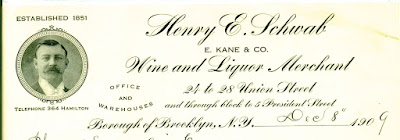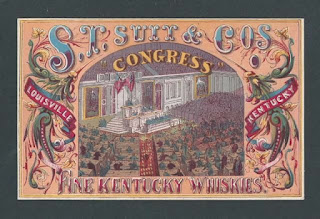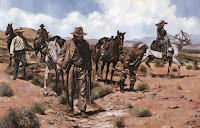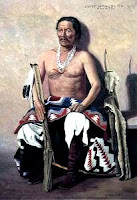John Morrin Made Whiskey Where Buffalo Roamed
 In Kansas City during the late 1880s, liquor dealer John Morrin faced a dilemma. Although his proprietary brands of whiskey sold well in Missouri and neighboring states, he was finding it difficult to get whiskey to blend as numerous dealers vied for supplies and the Whiskey Trust fought to dominate markets. By looking 600 miles east, Morrin found a small distillery in a Kentucky village named for a buffalo wallow — bought it and prospered.
In Kansas City during the late 1880s, liquor dealer John Morrin faced a dilemma. Although his proprietary brands of whiskey sold well in Missouri and neighboring states, he was finding it difficult to get whiskey to blend as numerous dealers vied for supplies and the Whiskey Trust fought to dominate markets. By looking 600 miles east, Morrin found a small distillery in a Kentucky village named for a buffalo wallow — bought it and prospered.
Morrin was born on a farm in Delaware County, Pennsylvania, to Patrick and Honora Graham Morrin, both natives of Ireland. He received his elementary and secondary education in Pennsylvania, moving to Missouri when he was 18 as his family sought a larger farmstead. Apparently with some training as a bookkeeper, he moved to Kansas City where in 1881 he appears in city directories keeping the books for W.C. Glass wholesale liquor dealers.
Morrin apparently showed a strong aptitude for the whiskey trade and in 1883 was advanced to traveling salesman for Glass. By 1887 he was performing the same work for another local liquor firm, Martin, Perry & Company. Before long Morrin decided to start his own liquor house in Kansas City. About 1890, with associates E. T. Powers as vice president and George Beamish as secretary, he opened Morrin, Powers & Company on Delaware Street in Kansas City, the major thoroughfare shown below. Within four years he changed the firm’s name to Morrin, Powers Mercantile Company.
 From the outset Morrin demonstrated a flair for advertising his whiskey brands. They included “Fairmount Club,” “Grand Canyon,” “Palmetto,” and “Setter Pure Rye.” He trademarked Grand Canyon in 1905 and Fairmont Club and Palmetto whiskies in 1906. Initially “King Bourbon” was his flagship brand, along with “Setter Pure Rye.” Shown here is a serving tray made of porcelain that advertises both brands. It was made in Carlsberg, Austria, by the Victorian pottery factory and was a fairly pricey item to be gifted to the saloons and restaurant carrying Morrin’s whiskey.
From the outset Morrin demonstrated a flair for advertising his whiskey brands. They included “Fairmount Club,” “Grand Canyon,” “Palmetto,” and “Setter Pure Rye.” He trademarked Grand Canyon in 1905 and Fairmont Club and Palmetto whiskies in 1906. Initially “King Bourbon” was his flagship brand, along with “Setter Pure Rye.” Shown here is a serving tray made of porcelain that advertises both brands. It was made in Carlsberg, Austria, by the Victorian pottery factory and was a fairly pricey item to be gifted to the saloons and restaurant carrying Morrin’s whiskey.
Both brands warranted his issuing saloon signs, shown above, featuring a lion on a King Bourbon print and a Setter Rye wall hanging. To his customers Morrin also gave away a picture of a nude model lying on a bearskin rug next to a pile of her discarded clothing. Interestingly, this sign does not advertise any specific whiskey.
In apparent effort to move beyond selling his own proprietary brands, Morrin looked to one of Kentucky’s premier distillers, Col. E. J. Taylor Jr. of Frankfort, Kentucky [See post on Taylor. January 10, 2015]. Two of Taylor’s most popular brands were Carlisle and O.F.C whiskeys. Morrin advertised both vigorously as: “The most perfectly distilled of any on the market and their purity recommends them as especially desirable for medical use.”
In another ad shown above, Morrin made an effort to distinguish his liquor house from the many other dealers in Kansas City by a series of claims: “We import more liquors than all other firms on the Missouri River.” “We own more Straight Whiskies than all other Liquor Firms in Kansas City.” “We carry more insurance than all other wholesale liquor firms in Kansas City.” Morrin also claimed a one year increase in business amounting to $100,000, several millions in todays dollar.
Morrin’s boasts did nothing to ameliorate the dilemma, he was facing. Supplies for his house brands were becoming increasingly expensive and more and more difficult to secure. The Whiskey Trust was buying out distilleries and shutting many down in an effort to increase prices for liquor stocks. Morrin looked for opportunities to buy his own distillery. In 1890 he found it in a place in called Stamping Ground, Kentucky, population 331.
Both the location and the distillery bore histories. The area had gained its name, Stamping Ground to memorialize the American bison (buffalo) that once roamed there. Before being wiped out by hungry settlers, the animals were attracted to the site by salt licks, availability of spring water, “seeps” for wallowing, and a tasty clover species the locals called “buffalo clover.”
Originally constructed as a woolen mill, the building had been converted to a distillery by Robert Samuels. Not a full time distiller, Samuels is said to have made a barrel of whiskey only occasionally and eventually was forced to dispose of the property at a sheriff’s sale in 1873. A series of owners followed.
 The first was Kinzea Stone, shown here, an entrepreneur with property holdings in nearby Georgetown, Kentucky, and four other states. Although Stone indicated an interest in producing and selling a whiskey commercially, other distractions intervened. In 1882 he sold the distillery to the Crigler family of Cincinnati [See post on Crigler, January 10, 2012]. They began producing 15 gallons of whiskey a day under the name “Buffalo Springs.” The company name became Mullins, Crigler & Company. In time the Criglers departed and the name was changed once again to A. B. Mullins Company.
The first was Kinzea Stone, shown here, an entrepreneur with property holdings in nearby Georgetown, Kentucky, and four other states. Although Stone indicated an interest in producing and selling a whiskey commercially, other distractions intervened. In 1882 he sold the distillery to the Crigler family of Cincinnati [See post on Crigler, January 10, 2012]. They began producing 15 gallons of whiskey a day under the name “Buffalo Springs.” The company name became Mullins, Crigler & Company. In time the Criglers departed and the name was changed once again to A. B. Mullins Company.
This was the distillery that John Morrin, in far off Kansas City, saw as an opportunity to break out of the dilemma of finding sufficient liquor to blend, bottle and merchandise. In about 1890 he bought the plant, continuing to produce whiskey using the recipes from the Criglers. Applying his talents as a salesman, according to whiskey historian Sam Cecil, Morrin’s distillery “soon made a wide reputation, particularly in the West.”
Morrin’s two main brands were “Buffalo Springs,” a sour mash bourbon, and “Stamping Ground,” a rye whiskey Other labels were “Buffalo Bourbon” and Scott County.” By the mid-1890s, the Kansas City proprietor had increased distillery mashing capacity to 100 bushels a day and had four warehouses with capacity for aging 2,500 barrels. Morrin issued a whetstone as a customer giveaway that emphasized the buffalo ties.
After almost a decade operating the Stamping Ground distillery, Morrin sold it to a Paris, Kentucky, partnership of Haynes & Trumble, whose company had been major customers for his whiskey The reason for the sale may well have been the distance of the distillery from Kansas City. A decade of constant travel between sites and the need for employee supervision from afar may have been wearing on Morrin and his family life.
 Like many young Irishmen, Morrin had married relatively late. At 32 he wed Caroline, a woman just slightly younger, who apparently had been married earlier and brought two daughters, Juanita and Eulalia, to their union. Morrin provided them with a large home in a fashionable neighborhood of Kansas City, shown here. The household included one live-in maid.
Like many young Irishmen, Morrin had married relatively late. At 32 he wed Caroline, a woman just slightly younger, who apparently had been married earlier and brought two daughters, Juanita and Eulalia, to their union. Morrin provided them with a large home in a fashionable neighborhood of Kansas City, shown here. The household included one live-in maid.
Despite the success of his Kansas City liquor house, Morrin could see his sales being curtailed by Prohibitionist pressures. Missouri was safely “wet,” but one after another Western states were going “bone dry.” Several years after selling the Buffalo Springs distillery, Morrin closed down his liquor business and retired to invest in other local enterprises. Those included the Traders’ Bank of Kansas City and the city’s Racing and Fair Association.
Morrin lived long enough to see National Prohibition repealed, dying in 1934 at the age of 75. He was buried in the Mount Calvary Catholic Cemetery in nearby Holden, Missouri. His memorial and gravestone are shown below.
After Repeal new ownership bought the the distillery and after a fire rebuilt it. Shown below, as refurbished, the Stamping Grounds facility once again was turning out good whiskey. In 1941 the property was purchased by Schenley who operated the plant for almost 20 years but shut it down in 1960. Today all that remains of the distillery John Morrin put on the “whiskey map” is the old stone headquarters building.
Note: This post was created from a variety of sources. Two primary references were “Bourbon in Kentucky, A History of Distilleries in Kentucky,” by Chester Zoeller, Butler Books, Louisville 2010, and “The Evolution of the Bourbon Whiskey Industry in Kentucky,” by Sam K. Cecil, Turner Publishing, Paducah KY, 2000. Unfortunately I have been unable to find a picture of John Morrin to enchance this story but hope some alert reader may be able eventually to supply one.


















































































































.jpg-%20R.jpg)





%20png-%20R.jpg)
